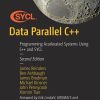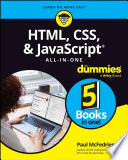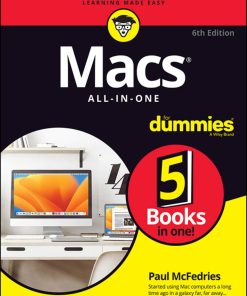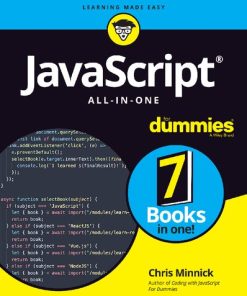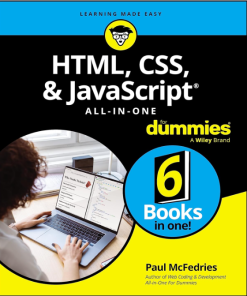C 10.0 All in One For Dummies 1st Edition by John Paul Mueller 1119839088 9781119839088
$50.00 Original price was: $50.00.$25.00Current price is: $25.00.
C# 10.0 All-in-One For Dummies 1st Edition by John Paul Mueller – Ebook PDF Instant Download/DeliveryISBN: 1119839088, 9781119839088
Full download C# 10.0 All-in-One For Dummies 1st Edition after payment.
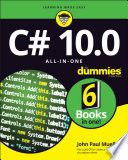
Product details:
ISBN-10 : 1119839088
ISBN-13 : 9781119839088
Author: John Paul Mueller
PRIMARY AUDIENCE: Coding students or aspiring computer programmer who want a foundation for learning C#. Experienced programmers who want to expand their programming languages or refresh themselves on the newest updates.
C# 10.0 All-in-One For Dummies 1st Table of contents:
Chapter 1: Creating Your First C# Console Application
Getting a Handle on Computer Languages, C#, and .NET
Creating Your First Console Application
Making Your Console App Do Something
Reviewing Your Console Application
Replacing All that Ceremonial Code: Top-Level Statements
Introducing the Toolbox Trick
Interacting with C# Online
Working with Jupyter Notebook: The Short Version
Chapter 2: Living with Variability — Declaring Value-Type Variables
Declaring a Variable
What’s an int?
Representing Fractions
Handling Floating-Point Variables
Using the Decimal Type: Is It an Integer or a Float?
Examining the bool Type: Is It Logical?
Checking Out Character Types
What’s a Value Type?
Comparing string and char
Calculating Leap Years: DateTime
Declaring Numeric Constants
Changing Types: The Cast
Letting the C# Compiler Infer Data Types
Chapter 3: Pulling Strings
The Union Is Indivisible, and So Are Strings
Performing Common Operations on a String
Comparing Strings
What If I Want to Switch Case?
Looping through a String
Searching Strings
Getting Input from Users in Console Applications
Controlling Output Manually
Formatting Your Strings Precisely
StringBuilder: Manipulating Strings More Efficiently
Chapter 4: Smooth Operators
Performing Arithmetic
Performing Logical Comparisons — Is That Logical?
Matching Expression Types at TrackDownAMate.com
Chapter 5: Getting into the Program Flow
Branching Out with if and switch
Here We Go Loop-the-Loop
Looping a Specified Number of Times with for
Chapter 6: Lining Up Your Ducks with Collections
The C# Array
Processing Arrays by Using foreach
Sorting Arrays of Data
Using var for Arrays
Loosening Up with C# Collections
Understanding Collection Syntax
Using Lists
Using Dictionaries
Array and Collection Initializers
Using Sets
Chapter 7: Stepping through Collections
Iterating through a Directory of Files
Iterating foreach Collections: Iterators
Accessing Collections the Array Way: Indexers
Looping Around the Iterator Block
Chapter 8: Buying Generic
Writing a New Prescription: Generics
Classy Generics: Writing Your Own
Understanding Variance in Generics
Chapter 9: Some Exceptional Exceptions
Using an Exceptional Error-Reporting Mechanism
Can I Get an Exceptional Example?
Working with Custom Exceptions
Planning Your Exception-Handling Strategy
Grabbing Your Last Chance to Catch an Exception
Throwing Expressions
Chapter 10: Creating Lists of Items with Enumerations
Seeing Enumerations in the Real World
Working with Enumerations
Creating Enumerated Flags
Defining Enumerated Switches
Working with Enumeration Methods
Book 2: Object-Oriented C# Programming
Chapter 1: Showing Some Class
A Quick Overview of Object-Oriented Programming
Defining a Class and an Object
Accessing the Members of an Object
Working with Object-Based Code
Discriminating between Objects
Can You Give Me References?
Classes That Contain Classes Are the Happiest Classes in the World
Generating Static in Class Members
Defining const and readonly Data Members
Chapter 2: We Have Our Methods
Defining and Using a Method
Method Examples for Your Files
Having Arguments with Methods
Using the Call-by-Reference Feature
Defining a Method with No Return Value
Returning Multiple Values Using Tuples
Chapter 3: Let Me Say This about this
Passing an Object to a Method
Comparing Static and Instance Methods
Accessing the Current Object
Using Local Functions
Chapter 4: Holding a Class Responsible
Restricting Access to Class Members
Why You Should Worry about Access Control
Defining Class Properties
Using Target Typing for Your Convenience
Dealing with Covariant Return Types
Getting Your Objects Off to a Good Start — Constructors
Using Expression-Bodied Members
Chapter 5: Inheritance: Is That All I Get?
Why You Need Inheritance
Inheriting from a BankAccount Class (a More Complex Example)
IS_A versus HAS_A — I’m So Confused_A
Other Features That Support Inheritance
Chapter 6: Poly-what-ism?
Overloading an Inherited Method
Polymorphism
C# During Its Abstract Period
Sealing a Class
Chapter 7: Interfacing with the Interface
Introducing CAN_BE_USED_AS
Knowing What an Interface Is
Using an Interface
Using the C# Predefined Interface Types
Looking at a Program That CAN_BE_USED_AS an Example
Unifying Class Hierarchies
Hiding Behind an Interface
Inheriting an Interface
Using Interfaces to Manage Change in Object-Oriented Programs
Chapter 8: Delegating Those Important Events
E.T., Phone Home — The Callback Problem
Defining a Delegate
Pass Me the Code, Please — Examples
A More Real-World Example
Shh! Keep It Quiet — Anonymous Methods
Stuff Happens — C# Events
Chapter 9: Can I Use Your Namespace in the Library?
Dividing a Single Program into Multiple Source Files
Working with Global using Statements
Dividing a Single Program into Multiple Assemblies
Putting Your Classes into Class Libraries
Going Beyond Public and Private: More Access Keywords
Putting Classes into Namespaces
Working with Partial Methods
Chapter 10: Improving Productivity with Named and Optional Parameters
Exploring Optional Parameters
Looking at Named Parameters
Using Alternative Methods to Return Values
Dealing with null Parameters
Chapter 11: Interacting with Structures
Comparing Structures to Classes
Creating Structures
Working with Read-only Structures
Working with Reference Structures
Using Structures as Records
Using the New Record Type
Book 3: Designing for C#
Chapter 1: Writing Secure Code
Designing Secure Software
Building Secure Windows Applications
Using System.Security
Chapter 2: Accessing Data
Getting to Know System.Data
How the Data Classes Fit into the Framework
Getting to Your Data
Using the System.Data Namespace
Chapter 3: Fishing the File Stream
Going Where the Fish Are: The File Stream
StreamWriting for Old Walter
Pulling Them Out of the Stream: Using StreamReader
More Readers and Writers
Exploring More Streams than Lewis and Clark
Chapter 4: Accessing the Internet
Getting to Know System.Net
How Net Classes Fit into the Framework
Using the System.Net Namespace
Chapter 5: Creating Images
Getting to Know System.Drawing
How the Drawing Classes Fit into the Framework
Using the System.Drawing Namespace
Chapter 6: Programming Dynamically!
Shifting C# Toward Dynamic Typing
Employing Dynamic Programming Techniques
Putting Dynamic to Use
Running with the Dynamic Language Runtime
Using Static Anonymous Functions
Book 4: A Tour of Visual Studio
Chapter 1: Getting Started with Visual Studio
Versioning the Versions
Installing Visual Studio
Breaking Down the Projects
Chapter 2: Using the Interface
Designing in the Designer
Paneling the Studio
Coding in the Code Editor
Using the Tools of the Trade
Using the Debugger as an Aid to Learning
Chapter 3: Customizing Visual Studio
Setting Options
Creating Your Own Templates
Book 5: Windows Development with WPF
Chapter 1: Introducing WPF
Understanding What WPF Can Do
Introducing XAML
Diving In! Creating Your First WPF Application
Whatever XAML Can Do, C# Can Do Better!
Chapter 2: Understanding the Basics of WPF
Using WPF to Lay Out Your Application
Arranging Elements with Layout Panels
Exploring Common XAML Controls
Chapter 3: Data Binding in WPF
Getting to Know Dependency Properties
Exploring the Binding Modes
Investigating the Binding Object
Editing, Validating, Converting, and Visualizing Your Data
Finding Out More about WPF Data Binding
Chapter 4: Practical WPF
Commanding Attention
Using Built-In Commands
Using Custom Commands
Using Routed Commands
Chapter 5: Programming for Windows 10 and Above
What is the Universal Windows Platform (UWP)?
Devices Supported by the UWP
Creating Your Own UWP App
Working with .NET Core Applications
Book 6: Web Development with ASP.NET
Chapter 1: Creating a Basic ASP.NET Core App
Understanding the ASP.NET Core Templates
Developing a Basic Web App
Chapter 2: Employing the Razor Markup Language
Avoiding Nicks from Razor
Creating Variables
Keeping Things Logical
Implementing Loops
Chapter 3: Generating and Consuming Data
Understanding Why These Projects Are Important
Serialized Data Isn’t for Breakfast
Developing a Data Generator and API
Creating a Consumer Website
People also search for C# 10.0 All-in-One For Dummies 1st:
c# all in one for dummies
c# 10.0 in a nutshell
c# 10.0 all-in-one for dummies review
c# 10.0 all-in-one for dummies cheat sheet
c# 10 for dummies pdf
You may also like…
Computers - Web Development
HTML, CSS, & JavaScript All-in-One For Dummies 1st Edition Paul Mcfedries
Computers - Mac OS
Computers - Web Development
Religion & Spirituality - Christianity
Catholicism All-in-One For Dummies 2nd Edition Rev. John Trigilio Jr.
Computers - Web Development
HTML, CSS, and jаvascript All-in-One For Dummies 1st Edition
Computers - Programming
C 10.0 All in One For Dummies 1st Edition by John Paul Mueller 1119839088 9781119839088
Computers - Programming
CODING ALL IN ONE FOR DUMMIES 2nd Edition by Chris Minnick 1119889571 9781119889571
Computers - Security
Computers - Programming
Beginning Programming with Python For Dummies 3rd Edition John Paul Mueller


